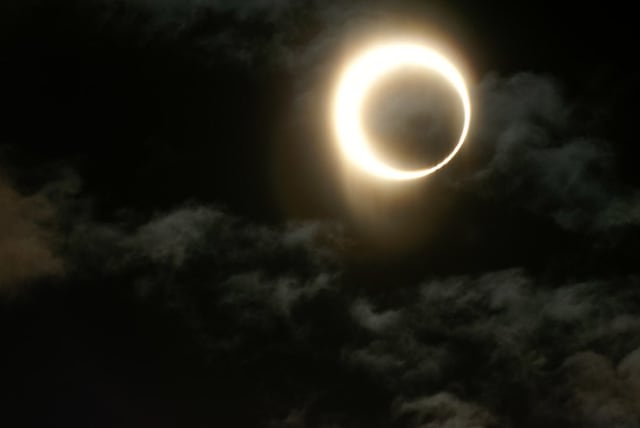Rare hybrid annular-total solar eclipse coming Thursday

The 2023 eclipse season is set to being on April 20th, starting with the rare hybrid solar eclipse.
Astronomy enthusiasts, make sure to mark your calendars! A rare hybrid annular-total solar eclipse will be seen in Australia, Southeast Asia, and into the Pacific Ocean region, according to Universe Today.
The 2023 eclipse season is set to begin on April 20th, starting with the rare hybrid solar eclipse.
What is a hybrid annular-total solar eclipse?
Some people will get to experience a spectacular celestial event as the moon's shadow cast a fleeting shadow over the Earth. The rare hybrid solar eclipse begins as a broken annular eclipse, which transitions into totality and then reverts back to an annular eclipse again.
The 49-kilometer-wide path of the eclipse will make a brief touchdown at sunrise over the Indian Ocean before brushing against land at three points.
The first landfall will occur over the Ningaloo Coast and the tiny town of Exmouth, on the northwestern tip of Australia.
The shadow will then make its way towards the Timor Sea and touch the eastern tip of the island nation of East Timor near its capital, Dili. It will then cross a scattering of Indonesian islands, including Kisar, the Schouten Islands and Western New Guinea.
The duration will only be one minute and 16 seconds, just south of the Indonesian island of East Timor in the Timor Sea.
How rare is the hybrid eclipse?
According to Michael Zeiler, an eclipse-chaser and researcher, the eclipse will have a total of about 2920 kilometers of broken annularity.
"The April 20, 2023 hybrid solar eclipse is notable in that it is longer in duration than most annular-totals and is the longest until October 17, 2172," Zeiler told Universe Today. "There is some true annularity at the end of the central path just before sunset, but with a brief duration of just over 4 seconds of annularity. This eclipse will have a total of about 2920 kilometers of broken annularity."
While solar eclipses are rare, they are more common than expected throughout the solar system.
On Mars, rovers routinely witness misshapen annular eclipses caused by the small Martian moons Deimos and Phobos. Additionally, Jupiter's major moons offer a similar spectacle to Earth during mutual transit season, with total solar eclipses featuring a sharp fit.
Interestingly, annular eclipses are becoming more common than total eclipses in the current epoch and will continue to become even more frequent over the next few hundred million years as the moon recedes from the Earth.
There are only seven hybrid eclipses in the 21st century, making up only 3.1% of solar eclipses overall, making the upcoming celestial event a rare and unique opportunity for astronomy enthusiasts and curious onlookers alike.
As the next week's solar eclipse approaches, millions of people across Australia and Southeast Asia are eagerly anticipating partial views of the celestial phenomenon.
While the central path of the eclipse has few inhabitants, those residing along its trajectory will be treated to a rare and spectacular sight.
However, it is essential to take proper precautions during all partial phases of the eclipse to ensure eye safety. To view the eclipse safely, make sure to use approved ISO 12312-2 glasses for viewing.
Jerusalem Post Store
`; document.getElementById("linkPremium").innerHTML = cont; var divWithLink = document.getElementById("premium-link"); if (divWithLink !== null && divWithLink !== 'undefined') { divWithLink.style.border = "solid 1px #cb0f3e"; divWithLink.style.textAlign = "center"; divWithLink.style.marginBottom = "15px"; divWithLink.style.marginTop = "15px"; divWithLink.style.width = "100%"; divWithLink.style.backgroundColor = "#122952"; divWithLink.style.color = "#ffffff"; divWithLink.style.lineHeight = "1.5"; } } (function (v, i) { });

